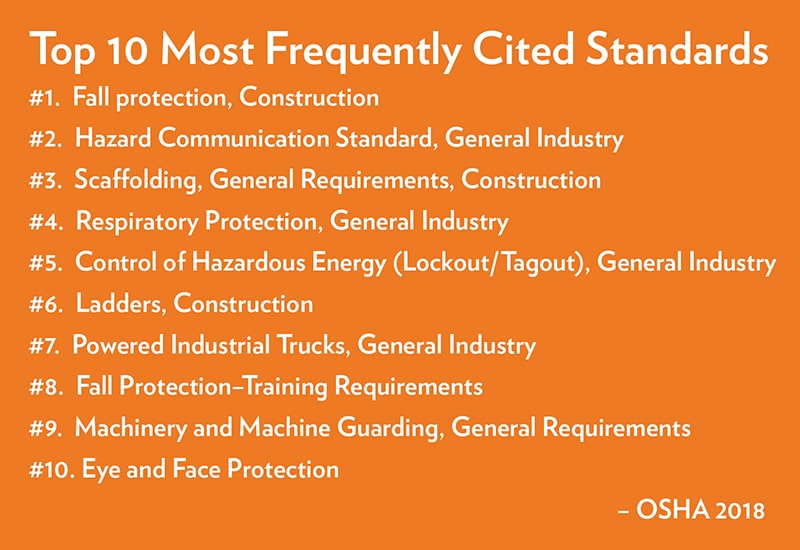Forget about “new year, new you.” Making safety a priority in 2020 will have a much more significant impact. This list of workplace safety tips is based on what our readers search for most. Focused on safety areas, this list will help you keep site workers and visitors safe and sound.

We’re kicking off our workplace safety tips with electricity because topics under this umbrella rank high on our most visited blogs. But it’s also important to note that “Control of Hazardous Energy” ranks #5 on OSHA’s most recent Top 10 Most Frequently Cited Standards.
Electricity is one of the most dangerous—and fatal—workplace hazards, and it can impact people who don’t work with it directly.
OSHA’s quick card covers the following best practices:
- No wire is safe. Assume that every wire is energized at a lethal voltage, even if it’s down or insulated.
- Don’t touch fallen power lines. Leave them to the experts and report them to your local utility company.
- Keep a safe distance. Stay ten feet or more away from clean-up and other activities involving electricity. And when working at heights, survey the area for overhead wires.
- Stay dry and avoid water. Never operate energized equipment when you are wet or standing in water. And, when working in damp locations, inspect cords and equipment to ensure
they are in good working condition.
- Leave repairs and inspections to the professionals. Electrical cord and equipment repairs should be left to qualified, authorized individuals. And qualified electricians should
inspect equipment that has gotten wet before use.
Despite our best efforts, emergencies can and will occur. It’s essential to have a proper, compliant plan in place.
OSHA offers an interactive online checklist to help you develop and implement an emergency action plan (EAP). This electronic safety tool covers:

We put it at number three on our workplace safety tips list, but you may want to make it your top priority. From working at height to slips and trips, most general industry accidents and 15% of all accidental deaths occur due to falls. OSHA estimates that every year, 200,000 serious injuries and 345 fatalities occur in the workplace.
The good news is most falls can be prevented when proper safety measures are in place. Here are some safety areas you can address to keep workers on their feet:
- Ladder Safety – Many workplace accidents involve ladders. “Ladders, Construction” made #6 of OSHA’s top violations list. Selecting the right ladder and using it correctly will keep
workers safe.
- Fall Prevention – Many steps must be taken to prevent falls. From general housekeeping to railing standards, taking the time to improve your facility will prevent injuries.
We perceive 80% of our surroundings through our eyes, making signage and labels a powerful tool for communicating safety standards in the workplace. They can also alert workers to hazards, promoting safer practices and actions.
“Hazard Communication Standard, General Industry,” was #2 on OSHA’s top violations list. In addition to following all safety standards in your industry (including OSHA’s and ANSI Z535), here are some things to consider:
- Make Customizations – Out of the box signage may not always be the right fit for your facilities. For example, you may need to make language adjustments for international workers.
- Communicate with Color – Studies show that color can improve comprehension by 40%. Using color improves recognition and emphasizes information.
- Create Your Own Labels – In some work environments, labels are not only required, but they’re also needed everywhere. With the right printer, you can easily make them yourself.
The final item on our top five workplace safety tips list is no less important than any of those above it. Personal protective equipment (PPE), guards, and safety devices are often the only thing standing between workers and hazardous materials and environments. Providing the proper PPE and installing guards and safety devices are essential steps to ensuring workers go home healthy and whole each day.
Unfortunately, safety violations are common in these areas. On OSHA’s list of top cited standards, “Respiratory Protection, General Industry” ranked #4, “Machinery and Machine Guarding, General Requirements” ranked #9, and “Eye and Face Protection” ranked #10.
Here are some resources to help you make the right choices for your workers and your facility:
- Emergency Eyewash Stations are a Must – Often overlooked, eyewash stations provide prompt relief to injured eyes and can prevent permanent damage.|
- Machine Guarding Saves Life and Limb – Each year, 18,000 workers suffer injuries when exposed to unguarded machines, and another 800 die from their injuries.
- Prevent Hearing Loss with Ear Protection – Noise is a threat you can’t see, but its impact can be lifelong.
This is the most important item on our workplace safety tips list because it is the list—the checklist. If you don’t regularly assess your safety program, you won’t know what’s missing, what’s changed, and what needs to be replaced. A great place to get started with an in-house assessment is our DIY Safety Check Workbook. Developed by an OSHA-certified trainer, this collection of 13 checklists will help you identify workplace hazards.
Our Safety Specialists are here to answer all your safety questions, provide guidance, and help you select the right safety products to meet your needs. We can even provide a professional assessment of your facility. Contact us today!
